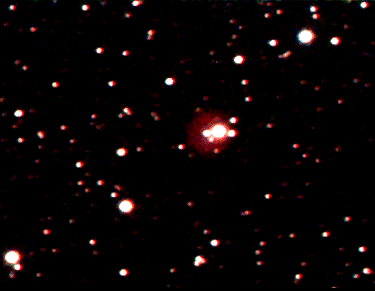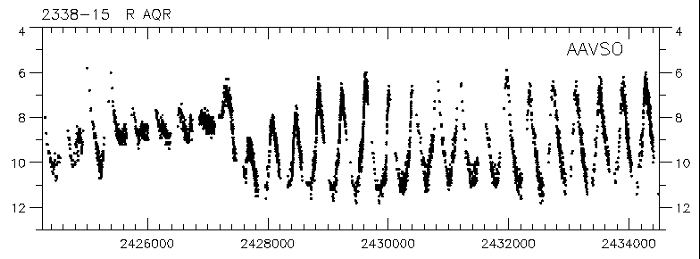

These pages include descriptions of stars which do not fit neatly into the presently-accepted types of variable star. This may be for two rerasons. First of all, the object in question may be a genuine "one off", or it may prove to be a member of a new or existing class of variable. It is too easy to generalise from one method of observation, for instance by looking at the light curve. We need to understand the astrophysics of the star, not just how it seems to vary in visible light. Parazoxically, that is one reason why visual observations are important. By looking at the optical variations, we can tell what a star is doing in the visual part of the spectrum; and comparing this with how it looks in (say) the infra-red areas we can get a more realistic view of what is going on than if we were to rely on just one small part of the whole electromagnetic spectrum.

The star pictured right, FG Sagittae, is one of these "one off" stars. When this page was first written (27 Feb 2000) it was still quite faint and difficult. As you can see from the photo, it has a very close companion (FG is the leftmost of the three stars in a little line), and it is very easy to confuse the two, since they are only ten arcseconds apart. I know - I have done it!
This particular star is enmeshed in what looks like a planetary nebula - but that does not mean it is a planetary nebula; these objects are formed as a result of the material thrown off periodically during the Mira-star stage of the life of certain stars, and astrophysically FG Sagittae does not look like an ex-Mira. This star needs constant monitoring, since it is so unpredictable and so different, as a section of the lightcurve from one of its active periods shows. Each division on the x-axis represents 50 days, and the whole curve covers about five years. Observers with CCD equipment are well equipped to study this star when faint, though visual observers can make useful observations as it brightens. This object was featured as a past "Variable Star of the Month" on the AAVSO's website, where you will be able to find out much more about it.

This is one of the most active and interesting variables I know of - and it is nearly always visible with binoculars, so you can find out more about it in the Cygnus section of my online Handbook of Binocular Astronomy. It is what is called a "Symbiotic" variable, a system which was once described as "Celestial cannibalism", though symbiotic implies that the two stars in the system are mutually dependent. In addition to this, the two stars periodically cause eclipses! This is a star which bears watching on every clear night - and sometimes several times a night in fact, since it has been thought subject to very short-term fluctuations too. If you catch it doing this, you may need to estimate every few minutes (say in between observing every three or four other stars so that you forget your previous estimate of CH and don't introduce bias). This object was also the subject of a long article in the AAVSO's "Variable star of the Month", where you can find light-curves of its behaviour as well as a great deal of information on symbiotic variables. Oh yes - it's easy to find and circumpolar too - at least from Britain. A real prize of a star. The lightcurve here shows its long-term variations over the past 50 years.


For many years this was thought to be a standard Mira star, quite bright, with a range of about 6 to 10; and then, in the thirties, it practically stopped varying altogether, a most un-Mira sort of thing to do, and there are suggestions that similar episodes may have happened earlier. Photographs revealed the presence of a filamentary-like nebula surrounding the star. This nebula is not in the catalogue of Messier, or even Herschel, but in that of the astronomer Cederblad. To my knowledge, R Aquarii has been behaving itself recently, but it just goes to show, even the most conventional-appearing stars are capable of surprising us. Like Mira itself, R Aquarii is a double star, composed of a large red star, i.e., the conventional large pulsating Mira-type object, and a tiny white dwarf; though unlike the Novae and the Dwarf Novae, it is not a condition of variability that Mira stars be double. R Aquarii appears to be a conventional mira star itself, but existing in a strange relationship with a second star, not too unlike the system of CH Cygni. Another famous "double variable" is Rasalgethi, or alpha Herculis, though in this case the variations are much more irregular and low-key than in the case of the Mira stars. The variable itself is easy to find and estimate, though you need a clear Southern horizon with no imperiments, since it is 15° South of the celestial equator. The section of the AAVSO long-term lightcurve shows the period during which the variations became strange and then resumed as normal.

This star was thought to be an old nova or a peculiar kind of U Geminorum star with some sort of anomalous form of interaction between the stars or, more likely, the accretion disk which is the chief source of the Dwarf Nova explosion. It is now known that it is a member of the so-called VY Sculptoris stars. These objects resemble U Gem stars in that they consist of a pair of stars, one small and hot, the other much larger and cooler. However, whereas U Gem stars spend most of their time at minimum from which they occasionally erupt, VY Scl stars spend a lot of time around maximum, plunging irregularly to minimum where they then undergo occasional outbursts, though not usually to the level from which they originally fell. Tellingly perhaps, VY Scl stars at minimum are spectrally similar to U Gem stars at minimum.
Since this behaviour of fading from maximum and then behaving irregularly is shown by other types of stars such as the R Coronae and nebular stars, some MV Lyrae-like stars have been placed in these groups. For instance, V751 Cygni was thought to be a nebular variable (it is associated with nebulosity and is in a star-forming region) but appears to be a VY Scl object
MV Lyr at maximum is of magnitude 12, but its frequent deep fades push it to below the sixteenth magnitude, from which state it will flare up and exhibit both long-term and short-term variation (over the course of hours or minutes!) Naturally, at such times, it is within the range of amateur instruments and becomes something of a magnet to visual observers, who are always looking for spectacular activity in variable stars (come on, guys, let's be honest here!) such as this one. In the light-curve here, note how the CCD observations show just how faint the star was when it was beyond the range of visual observers!
